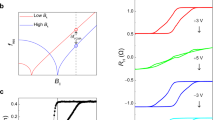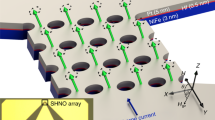Abstract
Synchronization of large spin Hall nano-oscillator (SHNO) arrays is an appealing approach toward ultrafast non-conventional computing. However, interfacing to the array, tuning its individual oscillators and providing built-in memory units remain substantial challenges. Here, we address these challenges using memristive gating of W/CoFeB/MgO/AlOx-based SHNOs. In its high resistance state, the memristor modulates the perpendicular magnetic anisotropy at the CoFeB/MgO interface by the applied electric field. In its low resistance state the memristor adds or subtracts current to the SHNO drive. Both electric field and current control affect the SHNO auto-oscillation mode and frequency, allowing us to reversibly turn on/off mutual synchronization in chains of four SHNOs. We also demonstrate that two individually controlled memristors can be used to tune a four-SHNO chain into differently synchronized states. Memristor gating is therefore an efficient approach to input, tune and store the state of SHNO arrays for non-conventional computing models.
This is a preview of subscription content, access via your institution
Access options
Access Nature and 54 other Nature Portfolio journals
Get Nature+, our best-value online-access subscription
$29.99 / 30 days
cancel any time
Subscribe to this journal
Receive 12 print issues and online access
$259.00 per year
only $21.58 per issue
Buy this article
- Purchase on Springer Link
- Instant access to full article PDF
Prices may be subject to local taxes which are calculated during checkout






Similar content being viewed by others
Data availability
The data that support the plots within this paper and other findings of this study are available from the corresponding author on request.
Code availability
The MATLAB and MuMax codes used in this study are available from the corresponding author on reasonable request.
References
Shalf, J. M. & Leland, R. Computing beyond Moore’s law. Computer 48, 14–23 (2015).
Buzsaki, G. Rhythms of the Brain (Oxford University Press, 2006).
Hsu, J. IBM’s new brain (news). IEEE Spectr. 51, 17–19 (2014).
Boybat, I. et al. Neuromorphic computing with multi-memristive synapses. Nat. Commun. 9, 2514 (2018).
Wang, Z. et al. Fully memristive neural networks for pattern classification with unsupervised learning. Nat. Electron. 1, 137 (2018).
Inagaki, T. et al. A coherent ising machine for 2000-node optimization problems. Science 354, 603 (2016).
Solli, D. R. & Jalali, B. Analog optical computing. Nat. Photonics 9, 704 (2015).
Torrejon, J. et al. Neuromorphic computing with nanoscale spintronic oscillators. Nature 547, 428 (2017).
Grollier, J. et al. Neuromorphic spintronics. Nat. Electron. 3, 360–370 (2020).
Manipatruni, S., Nikonov, D. E. & Young, I. A. Beyond CMOS computing with spin and polarization. Nat. Phys. 14, 338 (2018).
Ladd, T. D. et al. Quantum computers. Nature 464, 45 (2010).
Fang, Y., Yashin, V. V., Levitan, S. P. & Balazs, A. C. Pattern recognition with ‘materials that compute’. Sci. Adv. 2, e1601114 (2016).
Ignatov, M., Ziegler, M., Hansen, M. & Kohlstedt, H. Memristive stochastic plasticity enables mimicking of neural synchrony: memristive circuit emulates an optical illusion. Sci. Adv. 3, e1700849 (2017).
Kumar, S., Strachan, J. P. & Williams, R. S. Chaotic dynamics in nanoscale NbO2 Mott memristors for analogue computing. Nature 548, 318 (2017).
McMahon, P. L. et al. A fully programmable 100-spin coherent Ising machine with all-to-all connections. Science 354, 614–617 (2016).
Borders, W. A. et al. Analogue spin–orbit torque device for artificial-neural-network-based associative memory operation. Appl. Phys. Express 10, 013007 (2016).
Romera, M. et al. Vowel recognition with four coupled spin-torque nano-oscillators. Nature 563, 230–234 (2018).
Awad, A. A. et al. Long-range mutual synchronization of spin Hall nano-oscillators. Nat. Phys. 13, 292–299 (2017).
Demidov, V. E. et al. Magnetic nano-oscillator driven by pure spin current. Nat. Mater. 11, 1028–1031 (2012).
Demidov, V. E., Urazhdin, S., Zholud, A., Sadovnikov, A. V. & Demokritov, S. O. Nanoconstriction-based spin-Hall nano-oscillator. Appl. Phys. Lett. 105, 172410 (2014).
Yogendra, K., Fan, D., Jung, B. & Roy, K. Magnetic pattern recognition using injection-locked spin-torque nano-oscillators. IEEE Trans. Electron Devices 63, 1674–1680 (2016).
Zahedinejad, M. et al. Two-dimensional mutually synchronized spin Hall nano-oscillator arrays for neuromorphic computing. Nat. Nanotechnol. 15, 47–52 (2020).
Fulara, H. et al. Giant voltage-controlled modulation of spin Hall nano-oscillator damping. Nat. Commun. 11, 4006 (2020).
Dürrenfeld, P., Awad, A. A., Houshang, A., Dumas, R. K. & Åkerman, J. A 20 nm spin Hall nano-oscillator. Nanoscale 9, 1285–1291 (2017).
Awad, A. A., Houshang, A., Zahedinejad, M., Khymyn, R. & Åkerman, J. Width dependent auto-oscillating properties of constriction based spin Hall nano-oscillators. Appl. Phys. Lett. 116, 232401 (2020).
Zhang, T., Haider, M., Massoud, Y. & Alexander, J. An oscillatory neural network based local processing unit for pattern recognition applications. Electronics 8, 64 (2019).
Nikonov, D. E. et al. Coupled-oscillator associative memory array operation for pattern recognition. IEEE J. Explor. Solid-State Comput. Devices Circuits 1, 85–93 (2015).
Fang, Y., Yashin, V. V., Jennings, B. B., Chiarulli, D. M. & Levitan, S. P. A simplified phase model for simulation of oscillator-based computing systems. ACM J. Emerg. Technol. Comput. Syst. (JETC) 13, 14 (2017).
Wang, T., Wu, L. & Roychowdhury, J. New computational results and hardware prototypes for oscillator-based Ising machines. In DAC ’19: Proc. 56th Annual Design Automation Conference 2019, 239 (ACM, 2019).
Mohammad, B. et al. State of the art of metal oxide memristor devices. Nanotechnol. Rev. 5, 311–329 (2016).
Shiota, Y. et al. Induction of coherent magnetization switching in a few atomic layers of FeCo using voltage pulses. Nat. Mater. 11, 39–43 (2012).
Wang, W.-G., Li, M., Hageman, S. & Chien, C. L. Electric-field-assisted switching in magnetic tunnel junctions. Nat. Mater. 11, 64–68 (2012).
Kanai, S. et al. Electric field-induced magnetization reversal in a perpendicular-anisotropy CoFeB/MgO magnetic tunnel junction. Appl. Phys. Lett. 101, 122403 (2012).
Kanai, S. et al. Magnetization switching in a CoFeB/MgO magnetic tunnel junction by combining spin-transfer torque and electric field-effect. Appl. Phys. Lett. 104, 212406 (2014).
Kanai, S., Matsukura, F. & Ohno, H. Electric-field-induced magnetization switching in CoFeB/MgO magnetic tunnel junctions with high junction resistance. Appl. Phys. Lett. 108, 192406 (2016).
Zahedinejad, M. et al. CMOS compatible W/CoFeB/MgO spin Hall nano-oscillators with wide frequency tunability. Appl. Phys. Lett. 112, 132404 (2018).
Fulara, H. et al. Spin-orbit torque-driven propagating spin waves. Sci. Adv. 5, eaax8467 (2019).
Dvornik, M., Awad, A. A. & Åkerman, J. Origin of magnetization auto-oscillations in constriction-based spin Hall nano-oscillators. Phys. Rev. Appl. 9, 014017 (2018).
Zhu, L., Ralph, D. C. & Buhrman, R. A. Highly efficient spin-current generation by the spin Hall effect in Au1−xPtx. Phys. Rev. Appl. 10, 031001 (2018).
Kim, J.-Y. et al. Enhancement of spin Hall conductivity in W-Ta alloy. Appl. Phys. Lett. 117, 142403 (2020).
Gomez, J., Vourkas, I., Abusleme, A., Sirakoulis, G. C. & Rubio, A. Voltage divider for self-limited analog state programing of memristors. IEEE Trans. Circuits Syst. II: Express Briefs 67, 620–624 (2019).
Merced-Grafals, E. J., Dávila, N., Ge, N., Williams, R. S. & Strachan, J. P. Repeatable, accurate, and high speed multi-level programming of memristor 1T1R arrays for power efficient analog computing applications. Nanotechnology 27, 365202 (2016).
Tabor, P., Tiberkevich, V., Slavin, A. & Urazhdin, S. Hysteretic synchronization of nonlinear spin-torque oscillators. Phys. Rev. B 82, 020407 (2010).
Velichko, A., Belyaev, M., Putrolaynen, V. & Boriskov, P. A new method of the pattern storage and recognition in oscillatory neural networks based on resistive switches. Electronics 7, 266 (2018).
Velichko, A., Belyaev, M. & Boriskov, P. A model of an oscillatory neural network with multilevel neurons for pattern recognition and computing. Electronics 8, 75 (2019).
Parihar, A., Shukla, N., Jerry, M., Datta, S. & Raychowdhury, A. Vertex coloring of graphs via phase dynamics of coupled oscillatory networks. Sci. Rep. 7, 911 (2017).
Chou, J., Bramhavar, S., Ghosh, S. & Herzog, W. Analog coupled oscillator based weighted Ising machine. Sci. Rep. 9, 14786 (2019).
Langton, C. G. Computation at the edge of chaos: phase transitions and emergent computation. Phys. D: Nonlinear Phenom. 42, 12–37 (1990).
Romera, M. et al. Vowel recognition with four coupled spin-torque nano-oscillators. Nature 563, 230 (2018).
Li, Y., Wang, Z., Midya, R., Xia, Q. & Yang, J. J. Review of memristor devices in neuromorphic computing: materials sciences and device challenges. J. Phys. D: Appl. Phys. 51, 503002 (2018).
Acknowledgements
This work was partially supported by the Swedish Research Council (VR grant no. 2016-05980) and the Horizon 2020 research and innovation programmes grant nos. 835068 ‘TOPSPIN’ and 899559 ‘SpinAge’. The work at Tohoku University was supported by the Japan Society for the Promotion of Science Kakenhi grant nos. 17H06093 and 19H05622, JST-CREST grant no. JPMJCR19K3, and RIEC Cooperative Research Projects.
Author information
Authors and Affiliations
Contributions
S.F., S.K. and H.O. developed the material stacks. M.Z. designed and fabricated the devices, and carried out all measurements and data analysis. H.F. and A.H contributed to the data analysis. R.K. and M.D. carried out all micromagnetic simulations. J.Å. led the project. All authors contributed to the interpretation of the results and cowrote the paper.
Corresponding author
Ethics declarations
Competing interests
The authors declare no competing interests.
Additional information
Peer review information Nature Materials thanks Sergej Demokritov, Jianhua Yang and the other, anonymous, reviewer(s) for their contribution to the peer review of this work.
Publisher’s note Springer Nature remains neutral with regard to jurisdictional claims in published maps and institutional affiliations.
Supplementary information
Supplementary Information
Supplementary Figs. 1–6 and Discussion.
Rights and permissions
About this article
Cite this article
Zahedinejad, M., Fulara, H., Khymyn, R. et al. Memristive control of mutual spin Hall nano-oscillator synchronization for neuromorphic computing. Nat. Mater. 21, 81–87 (2022). https://doi.org/10.1038/s41563-021-01153-6
Received:
Accepted:
Published:
Issue Date:
DOI: https://doi.org/10.1038/s41563-021-01153-6
This article is cited by
-
Task-adaptive physical reservoir computing
Nature Materials (2024)
-
Nanograin network memory with reconfigurable percolation paths for synaptic interactions
Light: Science & Applications (2023)
-
Easy-plane spin Hall oscillator
Communications Physics (2023)
-
Weighted spin torque nano-oscillator system for neuromorphic computing
Communications Engineering (2023)
-
A robust graphene oxide memristor enabled by organic pyridinium intercalation for artificial biosynapse application
Nano Research (2023)



